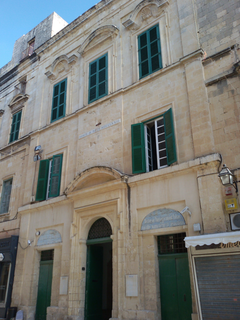Monte di Pietà (Malta)
| Monte di Pietà | |
|---|---|

Façade of the Monte di Pietà
|
|
| General information | |
| Status | Intact |
| Type | Palace |
| Architectural style | Baroque |
| Location | Valletta, Malta |
| Address | 46, Monte di Pietà Buildings, Merchant's Street |
| Coordinates | 35°53′51.4″N 14°30′49″E / 35.897611°N 14.51361°E |
| Current tenants | Inland Revenue Department |
| Completed | c. 1577 |
| Renovated | Mid-17th century 1773 |
| Owner | Government of Malta |
| Technical details | |
| Material | Limestone |
| Floor count | 3 |
| Design and construction | |
| Architect | Francesco Buonamici (façade only, attributed) |
The Monte di Pietà, formerly known as the Monte di Sant'Anna, is a charitable institution which lends money to those in need at modest interest rates, on the security of gold, silver or other precious articles given in pawn. In Malta the institution was set up in 1598, was known in the British period as the Public Pawn-Brokery, and it is still in operation today as part of the Inland Revenue Department. Since 1773, the Monte di Pietà has been housed in a 16th-century palace in Valletta.
The Monte di Pietà was founded on 15 January 1598 under the name Monte di Sant'Anna, when the Portuguese knight Fra Manuel de Couros obtained permission from Grand Master Martin Garzez to donate 2000 scudi so as to set up a fund to suppress usury, which was reportedly practiced by slaves and Jews. When it was first set up, the interest was two grani per scudo, and pawned valuables would be sold by auction after one year if the owner failed to pay back the money including the interest. From 1598, the institution was housed in part of the Banca Giuratale, but it later moved to the Castellania. It moved to its present premises in 1773.
In 1699, Grand Master Ramon Perellos y Roccaful assigned a total of 5372 scudi to the Monte. Part of this generous amount is attributed to a find during the project for the construction of Mdina Cathedral. During a demolition of a house, to make way for the Cathedral, construction workers had found gold coins in a medieval urn that date back to the Arab period. They were recognised through an Islamic creeds on a side of the coins, while on the other side the coins had three pears each similar to Perellos' coat-of-arms. Perellos claimed them as his, because of the similarity to the pears, but the bishop took the case to the papacy. Pope Innocent XII concluded that the Bishop had right over half of the findings, due to being found on the church's property, while the other half can be used generously for the Monte di Pietà. The funds of the institution were increased throughout the 18th century, including by the sale of tenements donated by Giuseppe Scipione Camilleri in 1712, and the transfer of funds from the Università and the Castellania to the Monte in 1720–1721 and 1724 respectively.
...
Wikipedia
